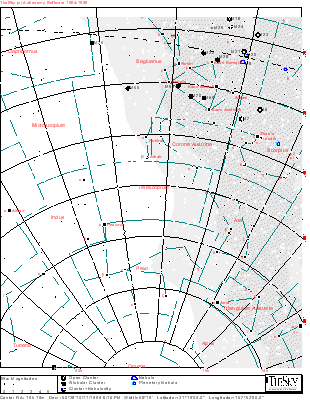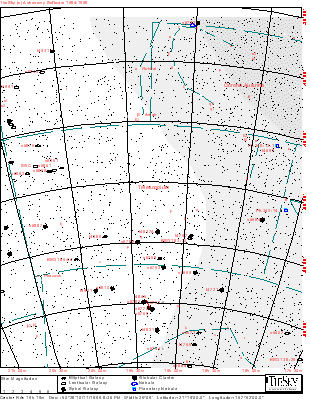
| Home | Deepsky Atlas | TheAstronews | Links | Solar System | ||||||

Hawaiian Astronomical SocietyConstellations: Telescopium -- Is Shorter Better? |
||||||||||
The telescope itself has an interesting, and long history. From its invention by the Dutch and Germans in the 16th century, Galileo developed the all lens (or refracting) design with a 20x instrument featuring less than a 15' field of view. It had a 2" (50mm) objective stopped down to 1" (25mm). By today's standards it must have been awful, like looking at rainbow fringed, fuzzy objects down the length of a straw.
The 1660s saw the development of three reflecting telescope designs by Gregory, Newton, and Cassegrain. These used polished mirrors made from speculum metal to form an image. These telescopes used two mirrors to form an image. William Herschel would reduce the number of mirrors to one in his late 18th century design. Observations through his telescopes laid the groundwork for the NGC catalog.
Refracting telescopes in the mid 17th century usually consisted of a 2"-3" (50-75mm) lens placed in an open frame several meters long. One of these aerial telescopes actually reached 200 ft. (about 60 meters) in length. The scopes needed such lengths to reduce the effects of color fringing called chromatic aberration, but their sheer ungainliness caused the reflector to dominate until the early to mid 18th century.
Chester Moore Hall discovered he could reduce color fringing by making an objective lens of two elements with differing refractive properties. The design allowed the length of a 3" telescope to shrink to about 45" (1200mm), a far cry from 200 feet. These relatively color free instruments are called achromatic refractors, and they are probably what Lacaille had in mind when he invented the constellation.

Click the map for a 929x1200 version of the above. Click here for a map better suited for use in the field.

This a more detailed view of the constellation. The map displays stars to magnitude 10, and deepsky objects to magnitude 12. Click here for a map better suited for use in the field.
 34k JPEG NGC6584 (Bennett 107) is a globular cluster located near the western border of Telescopium. Dreyer says it is quite bright, quite large, round, with a gradually much brighter middle, and well resolved. It contains stars of magnitude 15. A 12" should resolve the cluster; an 8" should begin to make it look "grainy" on a good night. 34k JPEG NGC6584 (Bennett 107) is a globular cluster located near the western border of Telescopium. Dreyer says it is quite bright, quite large, round, with a gradually much brighter middle, and well resolved. It contains stars of magnitude 15. A 12" should resolve the cluster; an 8" should begin to make it look "grainy" on a good night.
|
If you have any questions about the Hawaiian Astronomical Society
please
(link requires javascript).